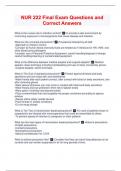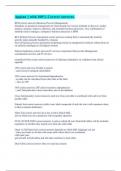NUR 222 Final Exam Questions and
Correct Answers
What is the nurses role in infection control? ✅To provide a safe environment by
minimizing exposure to microorganisms that cause disease and infection.
What are the universal precautions? ✅-Procedures followed by all staff
-Approach to infection control
-Concept: all human blood and body fluids are treated as if infectious for HIV, HBV, and
other blood borne pathogens
-Includes: use of Personal Protective Equipment, careful handling/disposal of sharps,
careful handling/cleaning of contaminated equipment
What is the difference between medical asepsis and surgical asepsis? ✅-Medical
asepsis: clean technique including handwashing and use of clean (nonsterile) gloves.
-Surgical asepsis: sterile technique.
What is Tier One of standard precautions? ✅-Protect against all blood and body
secretions and non-intact skin and membranes
-Wash hands after each patient contact, after contact with blood or body secretions, and
after removing gloves
-Wear gloves whenever you may come in contact with blood and body secretions
-Wear masks and eye protection when risk of splash exists
-Wear gown if clothing may become soiled
-Place contaminated linen and supplies into proper containers according to agency
policies
-Always utilize safety needle devices
-Place sharps in sharps containers
-Do not recap sharps
What is Tier Two of transmission-based precautions? ✅-For care of patients known or
suspected to be infected with microorganisms that could be transmitted to others
-To prevent spread of infection to caregivers or other patients
What are the main types of transmission-based precautions? ✅-Airborne precautions
-Droplet precautions
-Contact precautions
-Neutropenia precautions
-Special consideration for C-Diff
What is airbone precaution like? ✅-Consider that they can travel long distances on air
currents and can remain suspended in air for long periods of time.
,-Used with patients diagnosed with or suspected of being infected with illnesses
transmitted by very small airborne particles
-Examples: TB, chickenpox, measles
-Barriers required: private room, negative airflow, respirator or mask
What is droplet precaution like? ✅-Precautions used for diseases that are transmitted
by larger drops
-Transmission involves contact of the conjunctivae or the mucous membranes of the
nose or mouth
-Transmission occurs during coughing, sneezing, laughing, etc.
-Droplets travel short distances through air-up to three feet
-Examples: pneumonia, pertussis, mumps, meningococcal pneumonia, some
streptococcal infections, influenza, rubella
-Precautions include: private room or cohort client, mask when within 3 feet of patient
What is contact precaution like? ✅-Prevent transmission of diseases transmitted by
direct contact with the client or infected material.
-Examples: MRSA, VRE, lice, scabies, major draining wound, skin, GI, or urinary
infection, impetigo, conjunctivitis, especially when the organism is resistant to antibiotics
-Precautions include: the use of a private room or cohort client, gloves and gown when
potential to come in contact with infected material
~Gown
~Gloves
~Wash hands
What is protective isolation like? ✅-Also referred to as "Reverse Isolation" or
"Neutropenic Precautions"
-Protect patient from organism carried in by the caregiver.
-In this case we are protecting the patient from organism carried in by the caregiver
-E.g.: patients with low white blood cell counts r/t cancer/chemo, burns, transplants,
other immunosuppressed states)
-Don isolation attire before entering room and remove it outside the room
-The isolation attire needed is determined by the degree of immunosuppression
-Have dedicated equipment in their room like BP cuff, stethoscope, and thermometer.
What is the contact precautions for C.Diff? ✅-You should always wash your hands with
soap and water and not alcohol based hand rub when exiting the room.
-Equipment is cleaned/disinfected with Wet Task or PDI wipes followed by a bleach
solution.
What are protective precautions? ✅-Sign specific to your facility
-Used for patients with decreased ability to fight infection.
-Used with some cancer patient related to lower of the white count form chemotherapy.
~Mask (regular)
~No live flowers/plants
~Cooked foods only, no salads/fresh fruit/veggies
,~Private room
~Mask on pt during transport
What is important to know about PPE? ✅-Includes any apparel worn to protect health
care workers from exposure to disease
>E.g.: mask, gloves, gown, eye shields
-All PPE should be removed prior to leaving a work area
-Removal-should be placed in designated area or container
-Worn to protect health care workers from exposure to disease
-Protects other patients by preventing spread of microorganisms
What is the single most important procedure for preventing infections? ✅Hand
washing!!
What are the basic principles of handwashing? ✅-Purpose is to remove soil and
transient germs
-Components of good hand washing include using an adequate amount of soap,
rubbing the hands together to create some friction, and rinsing under running water
-Use: soap, antimicrobial handwash for 20 seconds, 1 in above wrist
When do you perform hand washing vs alcohol based rub? ✅-Perform hand hygiene
with alcohol-based rub:
>Before and after each patient contact/environment
>After removing gloves
-Wash:
>When hands are visibly soiled
>After contact with any bodily fluids
>Before eating, after using the restroom
>Exposure to organism (c.diff)
What is the definition of blood transfusion? ✅Infusion of whole blood or blood
component into the patient's venous circulation.
When do you give a blood transfusion? ✅When a patients RBC, platelets, and
coagulation factors decrease to levels that comprise a patient's health.
What are the objectives of blood transfusion? ✅-Increase circulating blood volume
after surgery, hemorrhage, or trauma
-Provide selected cellular components as replacement therapy (clotting factors,
albumin, platelets)
-Increase RBCs in clients with severe anemia
What is the ABO system? ✅-Based on the presence or absence of A and B red cell
antigens.
-AB: individual with A and B antigens (Universal recipient)
, -A: individual with only A antigens (May take type A or O blood)
-B: individual with only B antigens (May take B or O blood)
-O: no antigens. (Universal donor, can only receive type O blood)
What is the Rh factor? ✅-Rh positive: individual with Rh factor
-Rh negative: individual without Rh factor
-Rh negative blood can only receive Rh negative blood
What is the role of an RN and the role of a student nurse in blood/blood product
administration? ✅-Transfusion of blood or blood products is the responsibility of the
Registered Nurse.
-Student nurses may take and record vital signs as directed by the RN.
What are the types of blood products? ✅-Whole blood
-Packed red blood cells (PRBC)
-Platelets
-Cryoprecipitate
-Fresh Frozen Plasma (FFP)
-Albumin
What is the administration of PRBC like? ✅-Has a filter
-Rate: 1 unit over 2-3hr, no longer than 4 hours
-ABO compatible
-Double checked
What is the administration of platelets like? ✅-Filtered in tubing
-Rate: as fast as patient can tolerate
-Not ABO compatible
-Double checked
What is the administration of cryoprecipitate like? ✅-Not filtered
-Rate: IVP over 3 minutes
-ABO compatibility is recommended
-Double checked
What is the administration of FFP like? ✅-Not filtered
-Rate: 200ml/hr
-ABO compatible
-Double checked
What is the administration of albumin like? ✅-Filtered in tubing
-Rate: 1-10ml/min (5%) or 0.2-0.4ml/min (25%)
-Not ABO compatible
-Not double checked





